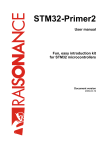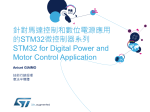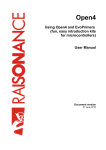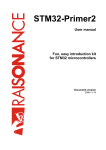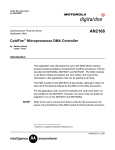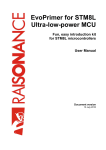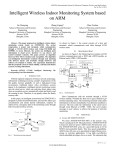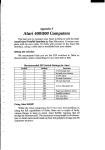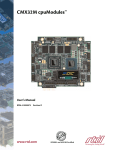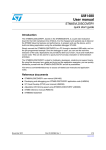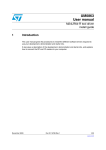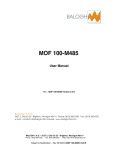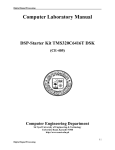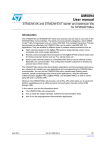Download EvoPrimer for STM32F Performance MCU Fun, easy introduction kit
Transcript
EvoPrimer for STM32F Performance MCU Fun, easy introduction kit for STM32F103VE microcontrollers User Manual Document version 09 September 2010 EvoPrimer for STM32F103VE Contents 1. Introduction.......................................................................................................................4 1.1 Purpose of this manual......................................................................................................................4 1.2 Scope of this manual.........................................................................................................................4 1.3 Additional help or information............................................................................................................4 2. Presentation.....................................................................................................................5 2.1 Base features.....................................................................................................................................5 2.2 Target board features........................................................................................................................5 2.3 Development software ......................................................................................................................5 3. EvoPrimer hardware.........................................................................................................6 3.1 Package contents..............................................................................................................................6 3.2 Components overview.......................................................................................................................6 3.3 Target board features........................................................................................................................7 3.3.1 STM32F103VE microcontroller features....................................................................................7 3.3.2 CAN............................................................................................................................................7 3.3.3 Audio codec................................................................................................................................7 3.3.4 Mini-USB connector....................................................................................................................7 3.4 Base features.....................................................................................................................................7 3.4.1 3D MEMS accelerometer............................................................................................................7 3.4.2 Power supply..............................................................................................................................7 3.4.3 Extension connector...................................................................................................................8 3.4.4 Application-specific extension boards......................................................................................10 4. Getting started................................................................................................................11 4.1 Switch on..........................................................................................................................................11 4.1.1 Insert the target board..............................................................................................................11 4.1.2 Connect battery, charge and power up.....................................................................................12 4.2 Using your EvoPrimer applications..................................................................................................12 4.2.1 Play...........................................................................................................................................12 4.2.2 Preinstalled applications...........................................................................................................13 4.3 Configuration menu..........................................................................................................................13 4.4 Compiling, programming and debugging.........................................................................................14 4.4.1 Install software..........................................................................................................................14 -2- EvoPrimer for STM32F103VE 4.4.2 Explore the STM32 Toggle application.....................................................................................14 5. Managing your CircleOS applications............................................................................15 5.1 CircleOS architecture.......................................................................................................................15 5.2 The CircleOS Scheduler..................................................................................................................15 5.2.1 Initialization stage.....................................................................................................................15 5.2.2 Periodic Systick interrupt..........................................................................................................16 5.2.3 Application scheduler................................................................................................................16 5.2.4 Periodic Timer2 interrupt..........................................................................................................16 5.3 CircleOS resource usage.................................................................................................................17 5.3.1 Memory usage..........................................................................................................................17 5.3.2 Resources used by CircleOS....................................................................................................18 5.4 Managing applications on your EvoPrimer......................................................................................19 5.5 Selecting the current application .....................................................................................................20 5.6 Downloading new applications.........................................................................................................20 5.7 Resetting your EvoPrimer................................................................................................................21 5.7.1 Hardware reset.........................................................................................................................21 5.7.2 Software reset - CircleOS.........................................................................................................21 5.7.3 Software reset - Factory configuration......................................................................................21 6. Developing CircleOS applications..................................................................................22 6.1 Developing your first CircleOS application.......................................................................................22 6.2 Libraries...........................................................................................................................................22 6.3 Debugging your application..............................................................................................................23 6.4 Sharing your application with the Circle community........................................................................23 7. Conformity and recycling................................................................................................24 8. Glossary.........................................................................................................................25 9. Index...............................................................................................................................26 10. History..........................................................................................................................27 -3- 1. Introduction EvoPrimer for STM32F103VE 1. Introduction The EvoPrimer for STM32F Performance Line is a fun, cost-effective evaluation and development package based on Raisonance's versatile, innovative Open4 platform and STM32F103VE target board. Note: The ST product EvoPrimer for STM32F Performance Line (ST order code: STM3210EPRIMER) is a derivative product of the Raisonance Open4. The same EvoPrimer target boards, extension boards, software tools and sample applications are used with both EvoPrimer and Open4. 1.1 Purpose of this manual This manual provides an overview and installation procedure for your EvoPrimer. Armed with the knowledge in this manual users can quickly understand the target microcontroller's features and create their own applications. 1.2 Scope of this manual This manual is applicable to all versions of EvoPrimer for STM32F Performance Line. It describes the EvoPrimer's basic use and its hardware and firmware features. Further information can be found in: - “LIS3LV02DL MEMS Inertial Sensor Data Sheet”, available from http://www.st.com/. - “STM32F103 Performance AC Line”, see http://www.st.com/. - “STM32F10x Flash programming manual”, see http://www.st.com/. - “STM32F10x advanced ARM-based 32-bit MCU reference manual”, see http://www.st.com/. - “STM32F10x Datasheet”, see http://www.st.com/. - “Cortex-M3 Technical Reference Manual” describes Cortex-M3 Core, see http://www.arm.com/. - “ILI9325 Datasheet” describes the 262K color single-chip TFT controller/driver, see http://www.ilitek.com/. - “LCM-TGG000240YP04-24 Model.pdf” describes the 320x240 display of the EvoPrimer base. - The GNU Compiler Collection (GCC) manuals are available from the Ride7 environment. Visit the Circle community web site at www.stm32circle.com for more resources and software tool downloads. 1.3 Additional help or information Please visit the Raisonance website: http://www.raisonance.com/ and the forum http://www.raisonance.com/Forum/punbb/ or contact Raisonance. Address: Raisonance S.A.S. 17, Avenue Jean Kuntzmann, 38330 Montbonnot Saint Martin France Telephone: +33 4 76 61 02 30 Fax: +33 4 76 41 81 68 Email: [email protected] If you find any errors or omissions, or if you have suggestions for improving this manual, please let us know by email. -4- EvoPrimer for STM32F103VE 2. Presentation 2. Presentation Your EvoPrimer is composed of two major hardware elements: a base platform, • a target board featuring an STM32F103VE. When the target board is connected to the base, the STM32F103VE drives the base's hardware features for evaluation purposes. When the base is connected to a PC the target microcontroller can be reprogrammed and application software can be created and debugged using the Ride7 Raisonance software tools. The target board also includes additional features that can be implemented in user applications, in addition to the features provided on the base. The following sections describe the features of the base and target board, software tools and basic procedures for their use. • 2.1 Base features The base provides the following capabilities: USB debug/programming connection (SWD for STM32) • QVGA (320x240) backlit color LCD, with touchscreen capability • Joystick/push button (mechanical) • 4 push buttons (based on touchscreen capability) • MicroSD card connector • Audio circuit with microphone/loudspeaker/jack • 3D MEMS accelerometer • Li-Ion battery with charge management circuitry • Add-on connector (USART, SPI, I2C, ADC,...) • 2.2 Target board features The STM32F103VE target board integrates the following hardware features: STM32F103VET6 microcontroller (512KB Flash, 64KB RAM) • USB device / host port • Dual CAN ports on terminals • 2.3 Development software The development software offered with the EvoPrimer provides everything you need to program an STM32F and debug applications, including: • USB host connection for in-circuit programming and debugging. • Ride7 integrated development environment for code editing, device programming and application debugging (debug up to 64K of code, with included version. For information about upgrade to an unlimited version of Ride, visit http://www.stm32circle.com/resources). • GNU C /C++ compiler (unlimited compiling) • CircleOS operating system and base services. An online community available at http://www.stm32circle.com makes it possible to share your EvoPrimer experience with others on the forums, retrieve useful resources, application notes, firmware, demos (C sources and projects) and applications, all available for free download. -5- 3. EvoPrimer hardware EvoPrimer for STM32F103VE 3. EvoPrimer hardware 3.1 Package contents Your EvoPrimer unit has been carefully packed. Examine the equipment for damage that may have occurred during shipment. If you find any damage, or if any of the items are not included, please contact Raisonance. Your EvoPrimer is delivered in two packages: 1. EvoPrimer base with USB cable. 2. STM32F103VE target board. Note: Download software tools after free registration at www.stm32circle.com 3.2 Components overview Here is a brief overview of the main components of the STM32F103VE target board: Debug / trace connector USB device connector STM32F103VET6 (512 KB FLASH) (64KB RAM) Audio codec Base connector -6- EvoPrimer for STM32F103VE 3. EvoPrimer hardware 3.3 Target board features 3.3.1 STM32F103VE microcontroller features The target board is equipped with an STM32F103VET6 from STMicroelectronics' STM32F Performance Line of 32-bit ARM Cortex-M3 core-based microcontrollers. Its main characteristics are: • ARM 32-bit Cortex™-M3 CPU, 72MHz, 90DMips with 1.25DMips/MHz, • • 512KB Flash program memory, 64KB SRAM, Embedded oscillators (for high-speed crystal + RTC), • • SWD debug interface, Fast input/output: up to 80 I/Os, ADC, DAC, • Embedded communication peripherals: USB 2.0, CAN, USART, SPI, I2C, LIN, IrDA, SDIO, • Multiple timers; watchdog, PWM, Systick timer, … 3.3.2 CAN The STM32F103VC target board includes one CAN port which is compliant with specifications 2.0A and B (active) with a bit rate up to 1 Mbit/s. Note: By default the CAN transceiver is not soldered on the board. 3.3.3 Audio codec The STM32F103VE target board includes and audio codec component (Ref. STW5094A) which supports voice quality audio features of the base (recording and playback). 3.3.4 Mini-USB connector The STM32F103VE target board includes a Mini-USB connector which can be used for USB 2.0 implementation in demonstration and user applications. 3.4 Base features 3.4.1 3D MEMS accelerometer The base is equipped with a MEMS inertial sensor (LIS3LV02DL from STMicroelectronics) which can be used to select commands in coordination with a graphic pointer. When you start the EvoPrimer for the first time, you will see a small ball moving according to the orientation of the EvoPrimer. The information about the 3D position is provided by the MEMS. 3.4.2 Power supply The EvoPrimer base features a 400mAh Li-Ion rechargeable battery, equipped with a voltage regulator and a battery charger. When the USB connector is linked to a PC, the host voltage (supplied by the PC) is used to recharge the battery. When no USB host is connected, the battery supplies the power for the EvoPrimer. When the battery is fully charged, the EvoPrimer can be used for about 6 hours. The duration of the batteries depends on the activity. -7- 3. EvoPrimer hardware EvoPrimer for STM32F103VE 3.4.3 Extension connector The base has a 20-pin HE14 female right-angle extension connector that you can access when removing the orange part of the case. The mechanical description of the extension board is available in the “resources” section of the www.stm32circle.com web site. The extension connector permits usage of the following pins: Pin Printed name STM32 pin STM32 name Description 1 V2V8 Vcc VCC Connected to the output of the U6 regulator (3.1V). This source could provide approximately 100mA to the extension board. 2 GND GND GND Ground 3 SCL PB.6 CX_I2CSCL Can be used either as a standard GPIO or considered as an alternate function: - I2C1_SCL (clock) - TIM4_CH1 - USART1_TX (if remapped) 4 SDA PB.7 CX_I2CSDA Can be used either as a standard GPIO or considered as an alternate function: - I2C1_SDA (data) - TIM4_CH2 - USART1_RX (if remapped) 5 MISO PB.4 SPI3_MISO Can be used either as a standard GPIO or considered as an alternate function: - SPI3_MISO / I2S3 (Serial Data) - SPI1_MISO (if remapped) - TIM3_CH1 (if remapped) 6 SD PB.5 SPI3_MOSI / I2S3_SD Can be used either as a standard GPIO or considered as an alternate function: - SPI3_MOSI / I2S3_SD (Serial Data) - SPI1_MOSI (if remapped) - TIM3_CH2 (if remapped) 7 SCK PB.3 SWO Can be used either as a standard GPIO or considered as an alternate function: - SPI3_SCK / I2S3_CK (clock) - SPI1_SCK (if remapped) - TIM2_CH2 (if remapped) Note that SWO is also connected to the embedded RLink for debug traces. This feature must be disabled when SPI3 or I2S3 is used with the extension board. 8 WS PA.15 JTDI_I2S3_WS Can be used either as a standard GPIO or considered as an alternate function: - I2S3_WS (Word Select) - TIM2_CH1_ETR (if remapped) 9 CANH CX_CANH -8- EvoPrimer for STM32F103VE Pin Printed name 10 CANL 11 ADC1 12 STM32 pin 3. EvoPrimer hardware STM32 name Description CX_CANL Connected to the CAN transceiver. When the CAN transceiver is not soldered, these pins could be easily connected to PB.8-PB.9 on the STM32 by shortcutting the signals on the footprint of the CAN transceiver. PC.4 CX_ADC1 Can be used either as a standard GPIO or considered as an alternate function: ADC12_IN14 ADC2 PC.5 CX_ADC2 Can be used either as a standard GPIO or considered as an alternate function: ADC12_IN15 13 A_TIM PB.0 CX_ADC_TIM Can be used either as a standard GPIO or considered as an alternate function: - ADC12_IN8 - TIM3_CH3 - TIM1_CH2N (if remapped) 14 CTS PA.0 CX_USART_CTS PA0/WKUP/ADC IN0Can be used either as a standard GPIO or considered as an alternate function: - WKUP - USART2_CTS - ADC12_IN0 - TIM2_CH1_ETR 15 RTS PA.1 CX_USART_RTS Can be used either as a standard GPIO or considered as an alternate function: - USART2_RTS - ADC12_IN1 - TIM2_CH2 16 TX PA.2 CX_USART_TX Can be used either as a standard GPIO or considered as an alternate function: - USART2_TX - ADC12_IN2 - TIM2_CH3 17 CK N/A P_BUTTON Push button input. Can wakeup the extension board. 18 RX PA.3 CX_USART_RX Can be used either as a standard GPIO or considered as an alternate function: - USART2_RX - ADC12_IN3 - TIM2_CH4 19 VEXT N/A VBAT Base battery voltage provided 20 GND VSS GND Ground Notes: Printed names on the extension board may not accurately match the pin names that exist for the STM32F103VE target board because the base is a generic design that supports other processor families (namely STM8) which do not share the same feature set as STM32. If you need CAN connectivity, you must solder a CAN transceiver (model MAX3051ESA from Maxim). Its footprint is identified on the picture below. -9- 3. EvoPrimer hardware EvoPrimer for STM32F103VE On Pin 7, SWO is used for ITM debug traces, for “printf” like functionality, thanks to the embedded RLink of your EvoPrimer base. SWO must not be enabled in your Ride7 project if you need to use SPI3 or I2S3 through the extension connector. The following picture shows the footprint for the (unsoldered) CAN transceiver. It is located on the bottom side of the board, under the plastic case. Illustration 3.1: CAN transceiver footprint 3.4.4 Application-specific extension boards The base has been designed to be extended through application-specific extension boards. Such extension boards connect to the extension connector and are compatible (mechanically and electronically) with the previous STM32-Primer2, so you should be able to reuse your previous designs without modification to the extension board. However, some limitations may apply, for instance if you use specific processor/peripheral capabilities that are not portable between designs. The following picture shows the mechanical constraints that you should respect to ensure that your extension board fits inside the EvoPrimer case. Extension board mechanical specifications - 10 - EvoPrimer for STM32F103VE 4. Getting started 4. Getting started This chapter explains how to switch on your EvoPrimer and describes the provided applications. 4.1 Switch on The procedure for getting started is reduced to four simple operations: 1. Insert a target board into the EvoPrimer base (see below). 2. Switch the power switch to provide current to the target board (see below). 3. Slide the transparent cover in place. 4. Press the joystick to power up the EvoPrimer. 4.1.1 Insert the target board The first thing to do is to insert the target board: 1. Remove the transparent cover. 2. Switch off the battery (see image below left). 3. Insert the target board into the base, as shown in the image, ensuring that the PCB is against the guides. 4. Push until the top of the target board fit with the side of the base. Inserting the target board Switching OFF the EvoPrimer - 11 - 4. Getting started EvoPrimer for STM32F103VE 4.1.2 Connect battery, charge and power up Your EvoPrimer is initially shipped with the battery disconnected in order to prevent discharging or harm occurring to the battery. You need to connect the battery before operating your EvoPrimer: 1. Open the EvoPrimer’s case by removing the cover which is on the target board. 2. Switch the button as shown on the image to power on your device. 3. Close the case. 4. Connect the EvoPrimer to the USB port on a PC to charge its battery. Only the red LED (L0) will be lit if the battery is charging. The green LED (L1) is lit when fully charged. 5. After charging the battery, press the push button to activate the EvoPrimer. 4.2 Using your EvoPrimer applications The base provides user interface features such as a color touchscreen, audio circuit, MEMS accelerometer-based navigation, joystick, push buttons, GUI, SD card connector, IrDA and much more. The target board operates evaluation features when connected to the base, and includes additional features such as audio codec and a USB connector. 4.2.1 Play After the opening screen is displayed, press the push button to call the main menu. Tilt the EvoPrimer backward/forward or use the joystick to navigate in the menu, use the push button to select a menu command. Initial menu items include: Config Configure parameters for the EvoPrimer including the pointer, backlight for the LCD display and time. Maze This is an addictive game provided as an example. Full source is available from www.stm32circle.com. Applic Select an application to run. The application that you choose will then appear in the main menu. SD card Display information saved on the SD card, or allows to configure your EvoPrimer as a mass storage device, and transfer files from/to your PC from/to the SD card. About Display information about the CircleOS version and available memory. Shutdown Turn off the EvoPrimer. To restart the EvoPrimer, simply press the push button. Quit Quit the menu. Note: When you receive the EvoPrimer, the MEMS based controls are calibrated to a “zero” position that matches a 30° angle from the horizontal (correspond s to the position of a book when reading). To practice controlling the EvoPrimer, move the blue dot around the main screen. It takes a little practice. - 12 - EvoPrimer for STM32F103VE 4. Getting started 4.2.2 Preinstalled applications The EvoPrimer includes preinstalled applications: ● Maze – A game where the player navigates inside a labyrinth, eating dots to win points while avoiding ghosts. ● Breakout – A game where the player uses a paddle to bounce a ball against a wall of blocks, destroying the block to win points. Win the game by destroying all the blocks. ● Square – A game where the player must avoid meeting moving squares. ● Graphics – Application that shows the drawing capabilities of the EvoPrimer. ● MP3 Player – Transforms your EvoPrimer to a MP3 player. Shows the audio and touchscreen capabilities of the EvoPrimer. ● Rec Wav – Transforms your EvoPrimer to a dictaphone. ● Drummer – Transforms your EvoPrimer in a musical beatbox. Shows the audio and touchscreen capabilities of the EvoPrimer. ● Cubic-4 – Last step of the tutorial, that transforms your EvoPrimer to a bubble level system. ● FontUser – Application that shows the font capabilities of your EvoPrimer. ● FsApp – Application that uses the full screen area as display. ● Scroll – Application that shows the hardware scroll capability. Explore a text with your finger, as on a smartphone. ● COMMTEST – Tests the USB com port, the joystick, and the MicroSD card connector. ● EchoIrDA – IrDA echo application, which makes it easy to connect your EvoPrimer to another IrDA appliance such as a cell phone or another EvoPrimer. 4.3 Configuration menu Configuration and test applications have been pre-installed to check your EvoPrimer’s capabilities. From the main menu of the EvoPrimer, launch the Config command. The following parameters can be set: 1. Power: CPU Freq:. Chooses the speed of your EvoPrimer. Backlight: Tunes the backlight intensity. Note that the backlight is the main source of power consumption (with the LCD monitor itself). Reducing the backlight intensity allow to extend the duration when the EvoPrimer is powered by the battery. 2. Interface: User input: Selects the user input for commands menu (accelerometer or joystick or accelerometer + joystick or touchscreen) Loudspeaker: enables or not the loudspeaker. If not, the sounds are only sent to the jack headphones connector. Menu: Selects whether or not to display the menu with a large font. Beep: Selects whether or not to send a “beep” when the EvoPrimer is tapped twice. TS Calibrate: Launches a calibration procedure of the touchscreen. 3. Autorun: The current application runs whenever your EvoPrimer is started. In this mode, there is no need to select the application in order to start it. 4. Time: Sets your EvoPrimer time. Note: the RTC clock remains valid even if your EvoPrimer is shutoff. 5. Test: Performs a quick factory test of the EvoPrimer. You can add more applications to your EvoPrimer by downloading them on the web site www.stm32circle.com/projects. Refer to the chapter 5 Managing your CircleOS applications - 13 - 4. Getting started EvoPrimer for STM32F103VE 4.4 Compiling, programming and debugging 4.4.1 Install software To explore, modify and create new applications on your EvoPrimer you need to install some software: 1. Register and download the CD-ROM-Image file on the Resource page of www.stm32circle.com. 2. Extract the files and install: • • Ride7, the Raisonance IDE to write and debug new applications. This includes the RLink driver which is necessary to pilot the programming and debugging of your EvoPrimer from your PC. RKit-ARM, the Ride7 add-on that contains the complete GNU software toolchain based on the GCC compiler. • Some utilities to manage your Circle applications (Circle is the OS embedded on your EvoPrimer; refer to Chapter5.1 "CircleOS architecture" for details). 3. Launch Ride7. 4. Connect your PC to the Debug USB port on the base. Complete tool documentation is provided with the software installation. Note: Ride7 should be installed before connecting to this USB port. 4.4.2 Explore the STM32 Toggle application Some examples are installed with the RKit-ARM for Ride7. For instance, this Toggle example will help you build and program a very simple EvoPrimer application: “[RIDE7_INSTALL_DIR]\Examples\ARM\Primer\STM32EvoPrimer\toggle_STM32E\toggle.rprj” Follow these steps in order to execute the example on your EvoPrimer : 1. Open Ride7. 2. Select Open | Project and navigate to the example. 3. Click on Project | Make Project. 4. Once the project is built, connect your EvoPrimer to your PC through USB. 5. Click Debug | Start. 6. Once the debugger is ready, you can run the example through Debug | Run. You can then play with the sample application on your EvoPrimer. - 14 - EvoPrimer for STM32F103VE 5. Managing your CircleOS applications 5. Managing your CircleOS applications 5.1 CircleOS architecture The STM32F103VE target board is equipped with an STM32F103 that contains 512KB of Flash ROM and 64KB of RAM. The EvoPrimer embeds the CircleOS operating system (source files are available from http://www.stm32circle.com/ after free registration). It provides services that will help you develop your STM32F EvoPrimer applications, including: 1. Application management, 2. LCD graphic functions, 3. MEMS functions, 4. LED, Buzzer and Push Button functions, 5. Menu functions, 6. Scheduler task, 7. Audio functions, 8. File system functions, 9. ... CircleOS can load several independent applications. Each application is run by CircleOS when selected, has the full availability of the CPU and can use all the RAM that is not being used by CircleOS (i.e. 16KB in the memory address range from 2000000h to 20003FFFh). It is scheduled by the CircleOS with full privileges on the device, until it explicitly quits. 5.2 The CircleOS Scheduler CircleOS acts in several stages: An initialization stage which occurs upon device reset, a periodic Systick interrupt, and the scheduling of applications. 5.2.1 Initialization stage During the initialization stage, the hardware configuration is performed, and the periodic system timer (Systick) is installed. The Systick period depends on the RCC settings: it can be modified through the menu Config | CPU Speed to the following predefined values: Reset Exception Initialization RCC_Configuration(); LED_Init(); MEMS_Init(); etc.... do_nothing Level 1 2 3 4 5 CPU freq (MHz) 18 24 36 48 72 Systick freq (kHz) 0.75 1 1.5 2 3 Systick Interrupt Periodic Actions The ratio CPU_freq / SysTick = 24000 applies for all these values. - 15 - BUTTON_Handler ( ); BUZZER_Handler ( ); MENU_Handler ( ); LCD_Handler ( ); etc... 5. Managing your CircleOS applications EvoPrimer for STM32F103VE 5.2.2 Periodic Systick interrupt The periodic Systick makes a call to the CircleOS Systick interrupt handler which performs a short process on each of the STM32-EvoPrimer components: LEDs, button, buzzer, LCD and so on. Note that the MEMS handler is called from the Timer2 interrupt, which has a priority higher than the Systick interrupt. This ensures a fixed and precise measurement rate. I2S transfers towards the audio Codec chip are handled through the DMA interrupt. 5.2.3 Application scheduler CircleOS is the base application of the EvoPrimer. It handles the menu selections and reacts to user actions. When an application is run (usually through a menu selection), CircleOS calls an initialization routine for the application, CircleOS then repeatedly calls the application handler at the Systick frequency until it returns a MENU_LEAVE value. You will find more details about programming CircleOS applications in Chapter 6 “Developing CircleOS applications”. 5.2.4 Periodic Timer2 interrupt The SPIs used to control the MEMS are both driven from the Timer2 interrupt handler which is triggered at a fixed rate: Level 1 2 3 4 5 CPU freq (MHz) 18 24 36 48 72 Systick freq (kHz) 0.75 1 1.5 2 3 Timer2 freq (Hz) 136.5 182 273 364 546 The Timer2 priority is higher than the Systick priority. It is mandatory to keep this IRQ at the highest level in order to guarantee proper MEMS behavior. Note: The frequency of the Timer2 overflow has been set to read a maximum number of measurements from the MEMS. However, this high rate is often useless, and you could easily change this frequency to save CPU time, or to get some more stable data from the MEMS. - 16 - EvoPrimer for STM32F103VE 5. Managing your CircleOS applications 5.3 CircleOS resource usage 5.3.1 Memory usage The CircleOS firmware requires 48KB of debug code in Flash, 200KB of constants and nondebuggable code in Flash and 12KB of RAM (including the stack usage for the applications). The remaining 264KB of Flash (512 – 248) are available for applications, which can be added or removed at will using a programming tool (see below). Flash memory can be programmed in 2KB blocks only. The following shows an example of memory mapping: FLASH 512KB Circle-OS (non debuggable part) 0x0807FFFF 132KB ... 0x0805F000 Application x 24KB ... Application 3 8KB 0x0801A800 ... Application 2 4KB RAM 64KB 0x08011000 ... OS 12KB 0x08010000 Free debug (64KB) Debuggable appli, 12KB 0x0800FFFF Circle-OS (debuggable part) 0x0800BFFF 48KB 0x08000000 Stack ↓ 0x2000FFFF 0x2000D000 0x0800C000 - 17 - Application data 52KB 0x20000000 5. Managing your CircleOS applications EvoPrimer for STM32F103VE 5.3.2 Resources used by CircleOS The following figure (from the ST datasheet) shows the peripherals used by CircleOS: - 18 - EvoPrimer for STM32F103VE 5. Managing your CircleOS applications 5.4 Managing applications on your EvoPrimer The applications can be managed by the circle_mgr.exe utility, which is in the directory [RIDE7_INSTALL_DIR]\Bin. This utility can: • List the currently loaded CircleOS applications. • Add new CircleOS applications. • Remove CircleOS applications. • Check how much FLASH memory is available. Refer to the http://www.stm32circle.com/ web site for more information about this utility. The following commands are available with the circle_mgr.exe utility: Command Syntax Description List L List the loaded applications. The following information will be output: circle_mgr.exe L Reading FAT table... App0: Name=Maze, Addr=0x08006000, Size=8KB App1: Name=Breakout, Addr=0x08008000, Size=4KB Largest free block= 92KB Add Afilename Add a new application (object file). circle_mgr.exe Ac:\tmp\level.o Linking file C:\tmp\level.o... Link of C:\tmp\level.o succeeded... Hex file generated... Blank-checking the FLASH area...OK Programming file _tmp_.ld.hex to flash...OK Registering application in FAT... OK Erase E* Eappname circle_mgr.exe EMaze circle_mgr.exe E* /*remove only 'Maze'*/ /*remove ALL apps */ Wait W When a command list is launched through a batch file, the W command allows you to pause the execution and to check the intermediate results. Start S Start CPU execution Caution: Any hex file can be programmed to the Flash memory of your EvoPrimer using the cortex_pgm.exe utility. However, doing this will destroy your CircleOS firmware, and you will have to reinstall it if you wish to use it later (refer to chapter 5.7for details). - 19 - 5. Managing your CircleOS applications EvoPrimer for STM32F103VE 5.5 Selecting the current application One application is considered to be the “current application”. The ID of the current application is saved in the backup memory. From the main menu, you can launch it directly. To change the current application, select the “Application” command from the main menu. Then select the application you wish to specify it as the “current application” and push the button. The new “current application” name will now appear in the main menu. 5.6 Downloading new applications On the http://www.stm32circle.com/projects Circle web site you will find a database where the members can share their applications with the stm32circle community. An application can include both the source files and the object files, or just the object files. An application is generally made of one object file, but may occasionally have several of them. The linking of the application in such a case can be done either using the circle_mgr.exe software (available in the “[RIDE7_INSTALL_DIR]\bin” directory) or within the Ride7 environment. When an application is split into several object files, these object files must be placed in a library in order to pass a unique filename as an argument to circle_mgr.exe. - 20 - EvoPrimer for STM32F103VE 5. Managing your CircleOS applications 5.7 Resetting your EvoPrimer 5.7.1 Hardware reset A hardware reset will restart your EvoPrimer (restoring it to a clean state), but will not remove its ROM contents. 1. Remove any USB cable. 2. Remove the plastic case protecting the target board. 3. Change the switch to its open state (this disconnects the internal battery) then replace the switch as it was. 4. Put the plastic case back in place. 5. Restart your EvoPrimer by pressing its button. 5.7.2 Software reset - CircleOS This software reset erases all the Flash memory in your EvoPrimer and all applications. The CircleOS is replaced. This operation takes approximately 30 seconds: 1. Connect your EvoPrimer’s debug USB port to your PC. 2. Power-up your EvoPrimer by pressing its button. 3. Open a command prompt from Windows (Start | Programs | Accessories | Command prompt). 4. Reload the initial program, using the command: Update_EvoPrimer_STM32E_Circle_OS.bat from Ride7 or Program_Evo_STM32E_CircleOS_only from stm32circle website in the upgrade zip file. Note: This operation can also be done with the following command: Cortex_pgm TSTM32F103VET6 E PEvo_Circle_STM32C.hex S where TSTM32F107VCT6 selects the appropriate device E erases the ROM. Evo_Circle_STM32E.hex is the full application available on the web site. S restarts the device. 5.7.3 Software reset - Factory configuration If you have been experimenting with CircleOS applications and have modified your EvoPrimer configuration, you may want to restore the initial (factory) configuration. This operation takes approximately 30 seconds: 1. Connect your EvoPrimer’s debug USB port to your PC. 2. Power-up your EvoPrimer by pressing its button. 3. Open a command prompt from Windows (Start | Programs | Accessories | Command prompt). 4. Launch the command Restore_EvoPrimer_STM32E_Circle_Factory.bat If the command is not recognized, change the current directory to the Ride7 installation directory. This can be done with the following command (adapt it to your actual configuration if you did not install Ride7 in its default location): cd "C:\program files\Raisonance\Ride\lib\ARM\CircleOS" 5. The batch script erases your EvoPrimer, reprograms it with its factory ROM image which is in the circle hex file, then restarts the device. Note: This operation can also be done with the following command: Cortex_pgm TSTM32F103VET6 E PEvo_STM32E_Circle_Factory.hex S where PEvo_STM32E_Circle_Factory.hex programs the device with the proper hex file. - 21 - 6. Developing CircleOS applications EvoPrimer for STM32F103VE 6. Developing CircleOS applications The full source files of CircleOS are available on the http://www.stm32circle.com/ web site. Once registered, you will be able to download them, along with many resources for developing your application. The games originally delivered with the EvoPrimer show working application examples. 6.1 Developing your first CircleOS application Creation of a CircleOS application is done automatically in Ride7: 1. Navigate to Project | New project. 2. Set the Type selection list to New application. 3. In the Processor selection list, select the STM32E_Evo_CircleOS device. 4. Select an application name such as My CircleOS application. 5. Define the location where your new project will be created. 6. Click the Finish button. Your new project will be created, with an application containing a CircleOS application skeleton as well as the Evo_Circle_STM32E.elf and FAT_OP4.elf files necessary to connect your application to CircleOS. 7. Open the Application.c file. 8. Search for the Application_Name variable in the file. 9. Change the Application_Name value from My App to HELLO. 10. In the Application_Handler function, create a new string as follows: const char msg[] = "Hello, World!"; 11. Use the DRAW_DisplayString CircleOS service to display the msg string variable you just created: DRAW_DisplayString( 5, 20, msg, sizeof(msg)); // X, Y, string, length 12. Connect your EvoPrimer to your PC using the USB cable (using the Prrimers debug USB port). 13. From Ride7, go to Debug | Start, this programs your application to your EvoPrimer. This may take about 15 seconds. 14. Go to Debug | Run. 15. On your EvoPrimer, select your application name on the main menu. Your application is now on your EvoPrimer. For further information about CircleOS application programming and available OS services, please visit http://www.stm32circle.com/. 6.2 Libraries Some common services are offered to ease your development of CircleOS applications. 1. The STM32 libraries, written by ST, provide access to the embedded peripherals (such as timers, ADC, communication interfaces, thermometer, etc...) of the STM32 microcontroller. 2. The low-level CircleOS functions that provide an easy access to the EvoPrimer’s on-board peripherals: 3D accelerometer, LCD monitor, button, buzzer, battery, LEDs. 3. The graphical functions that provide powerful high-level functionality: Menu management, pointers (linked to the 3D accelerometer), character maps, sound. The source files of these libraries can be found on: ● ST web site for the STM32 libraries (includes other documentation about the STM32 library) ● On the http://www.stm32circle.com/ web site for the CircleOS libraries (registration required). Library documentation is accessible from Ride7. - 22 - EvoPrimer for STM32F103VE 6. Developing CircleOS applications 6.3 Debugging your application In order to debug your application: 1. Go to Project | Properties in Ride7. 2. In the Configuration selection box, select the Circle_Debug configuration (which is the default). Ride7 takes care of all the settings required to switch between debug and release mode through the use of these configurations. Note: The standard STM32F EvoPrimer is limited to debugging in the first 64KB only. A software key can be purchased on http://www.stm32circle.com/ to allow debugging in the whole 512KB of memory. 6.4 Sharing your application with the Circle community Once your application works properly, you can share it with the other members through the http://www.stm32circle.com/ community. - 23 - 7. Conformity and recycling EvoPrimer for STM32F103VE 7. Conformity and recycling For more information on conformity and recycling, please visit the Raisonance website www.raisonance.com ROHS Compliance (Restriction of Hazardous Substances) Raisonance products are certified to comply with the European Union RoHS Directive (2002/95/EC) which restricts the use of six hazardous chemicals in its products for the protection of human health and the environment. The restricted substances are as follows: lead, mercury, cadmium, hexavalent chromium, polybrominated biphenyls (PBB), and polybrominated diphenyl ethers (PBDE). CE Compliance (Conformité Européenne) Raisonance products are certified to comply with the European Union CE Directive. In a domestic environment, the user is responsible for taking protective measures from possible radio interference the products may cause. FCC Compliance (Federal Communications Commission) Raisonance products are certified as Class A products in compliance with the American FCC requirements. In a domestic environment, the user is responsible for taking protective measures from possible radio interference the products may cause. WEEE Compliance (The Waste Electrical & Electronic Equipment Directive) As part of our continuing efforts to proved the best service to our users an communities, Raisonance is actively defining take-back and recycling programs for EU customers as part of the implementation of the European WEEE directive. The WEEE symbol is a reminder not to dispose of your electronic equipment in standard trash receptacles. For more information about disposal and recycling of electronic goods, please refer to http://www.raisonance.com/support/weee.php. Raisonance disposes of its electrical equipment according to the WEEE Directive (2002/96/EC). Upon request, Raisonance can recycle customer’s redundant products. - 24 - EvoPrimer for STM32F103VE 8. Glossary 8. Glossary Term Description STM32F EvoPrimer EvoPrimer for STM32F103VE MCU, a microcontroller evaluation & development platform EvoPrimer Commercial products which are derived from the Raisonance Open4 and distributed by STMicroelectronics for exploring, evaluating, developing and fine tuning applications for a variety of ST 8 and 32-bit microcontrollers. Certain use limitations may apply to these commercial products Open4 Raisonance versatile hardware platform, which is used in a variety of commercial products that allow users to explore, evaluate, develop and fine tune applications for a range of microcontrollers that are mounted on Open4 compatible target boards. Also refered to as the "base platform." Also distributed under the name EvoPrimer base Target board Boards featuring target microcontrollers which, when installed on an Open4derived base allow execution of applications, programming of the target microcontroller and debugging of the applications running on the target microcontroller. Hardware features of target boards will vary depending on the target MCU and its features. Some features of the base platform may not be available depending on the features and capabilities of the target microcontroller Extension board Application-specific extension board, connected to the extension connector. CircleOS Embedded OS running on the Primer development kits. - 25 - 9. Index EvoPrimer for STM32F103VE 9. Index Alphabetical Index Add.....................................................................19 Autorun...............................................................13 Backlight.............................................................13 Beep...................................................................13 Breakout.............................................................13 CE......................................................................24 CircleOS peripherals..........................................18 CircleOS Systick................................................16 COMMTEST.......................................................13 Compliance........................................................24 Conformity..........................................................24 cortex_pgm.exe..................................................19 CPU Freq...........................................................13 CPU Speed........................................................15 Cubic-4...............................................................13 Directive.............................................................24 Drummer............................................................13 EchoIrDA............................................................13 Erase..................................................................19 FCC....................................................................24 FontUser............................................................13 FsApp.................................................................13 Graphics.............................................................13 Lead...................................................................24 List......................................................................19 Loudspeaker......................................................13 Maze...................................................................13 Menu..................................................................13 MP3 Player.........................................................13 Power.................................................................13 Raisonance .......................................................24 Rec Wav.............................................................13 ROHS.................................................................24 Scroll..................................................................13 Square................................................................13 Start....................................................................19 STM32 Toggle....................................................14 Systick................................................................15 Test....................................................................13 Time...................................................................13 Timer2................................................................16 TS Calibrate.......................................................13 User input...........................................................13 Wait....................................................................19 Web site...............................................................4 WEEE.................................................................24 - 26 - EvoPrimer for STM32F103VE 10. History 10. History Date Modification 13 July 2010 Initial version. 09 Sept 2010 Memory maps update Preinstalled applications list (CircleOS v4.1) Disclaimer Information in this document is subject to change without notice and does not represent a commitment on the part of the manufacturer. The software described in this document is provided under license and may only be used or copied in accordance with the terms of the agreement. It is illegal to copy the software onto any medium, except as specifically allowed in the license or non disclosure agreement. No part of this manual may be reproduced or transmitted in any form or by any means, electronic or mechanical, including photocopying, recording, or information storage and retrieval systems, for any purpose other than the purchaser’s personal use, without prior written permission. Every effort has been made to ensure the accuracy of this manual and to give appropriate credit to persons, companies and trademarks referenced herein. This manual exists both in paper and electronic form (pdf). Please check the printed version against the .pdf installed on the computer in the installation directory, for the most up-to-date version. The examples of code used in this document are for illustration purposes only and accuracy is not guaranteed. Please check the code before use. Copyright © Raisonance 1987-2010 All rights reserved - 27 -



























